Introduction
The focus of the study is to identify the reasons for their remaining poor and backward, and designing a skills and employment strategy based on the ground conditions as revealed by the census data.
This Study relies on the data published by the Registrar General of India (RGI) based on Census 2011 and released through the District Census Handbook Series (DCHS). The DCHS gives district level information on various socio-economic parameters of the district as collected in the Census and provides a useful benchmark for districts to be compared at a particular point in time. 10 poor districts were chosen for the study as a representative sample of the poor districts in India. These districts form part of the initial 200 districts identified as ‘poor’ for implementation of Phase 1 of the MGNREGA (Mahatma Gandhi National Rural Employment Guarantee Scheme) programme in 2005.
The districts chosen for the Study are Adilabad (Telengana), Anantapur (Andhra Pradesh), Gaya (Bihar), Bastar (Chattisgarh), Dumka (Jharkhand), Balaghat (Madhya Pradesh), Gadichiroli (Maharashtra), Koraput (Odisha), Mirzapur (Uttar Pradesh) and Bankura (West Bengal). These districts have also been affected by the problem of left-wing extremism (LWE).
This paper has been divided into three sections. The first section deals with issues of natural resources in these districts and shows how these have not been instrumental in generating the necessary resources for the local development of the region. The second section focuses on the problems that these districts face in agriculture, education and health, leading to their poverty and backwardness. The third section focuses on devising ‘skills and employment strategy’, given their local resources, and the need to focus on human resources development and organizational interventions to promote self-employment and entrepreneurship.
A brief review of the literature shows that the discourse for the development of the poor LWE districts is divided. One school of thought treats it as a law and order issue while the other treats it as a development deficit issue. Without getting into the various schools of thought, we would try to see the various socio-economic parameters of these 10 districts, so as to focus on the areas of intervention in the skills and employment space.
Section 1: Rich mineral resource base of poor districts
It is important to understand the natural resource base of these districts. These districts are endowed with rich mineral and forest resources. The table 1 provides district-wise information on the major natural resources including forests and minerals.
Most of the districts have valuable forest as well as mineral resources. However, these resources very often are not accessed by the local population as they are in the control of outsiders who do the investment for business purposes while the local inhabitants depend upon them for wage employment. This phenomenon in effect is the general situation in almost all the sectors of the poor districts which have been affected by Left Wing Extremism (LWE). Therefore, there is the need to strengthen local governance in Panchayati Raj Institutions (PRIs) so that democratic decentralization takes place in letter and spirit. We would in the next section see the socio-economic parameters of these districts.
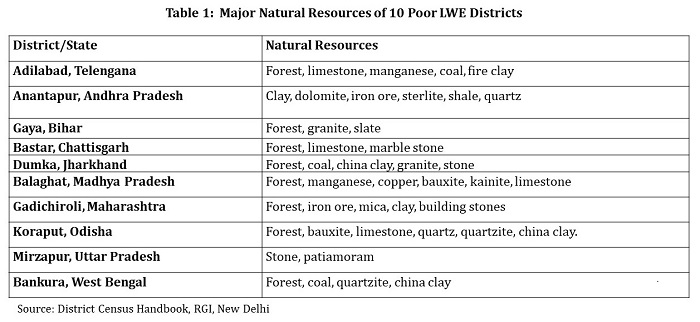
Section 2: Poor Status of Education and Health Infrastructure
It is also important to understand education and health infrastructure for every 10000 population in various towns of the districts.
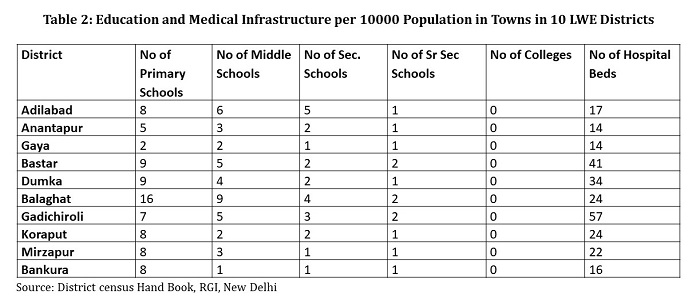
The available information shows how difficult it is to access education and health infra structure in towns of these districts. The literacy rates are low with Adilabad-49.8%, Anantapur-63%, Gaya-63.7%, Bastar-54.4%, Dumka-71%, Balaghat-77%, Gadichiroli-74%, kopraput-42%, Mirzapur-68% and Bankura-70.3%. In many cases, the literacy rates for the districts are below the state literacy rates and the national rate of 74%. The latest data available for various states shows that the literacy rate for Telengana is 66.46%, Andhra Pradesh 67.66%, Bihar 65.8%, Chattisgarh 65.9%, Maharashtra 82.3%, Odisha 72.9%, and West Bengal 77.1%. The states of Jharkhand (66.41%), Madhya Pradesh (70.6%) and Uttar Pradesh(57.2%) are the exceptions with the districts having a higher literacy rate than the entire state .While the literacy rate may not have a direct bearing on poverty and backwardness, a low literacy rate does create a barrier for any effective revival programme for the district inasmuch as skill formation and employability of people become more challenging with low rates.
We next take a look at the employment and occupational pattern of the districts as depicted by the Census 2011 data. Table Three presents information on the employment pattern while Table Four presents information on the occupational pattern of the districts.
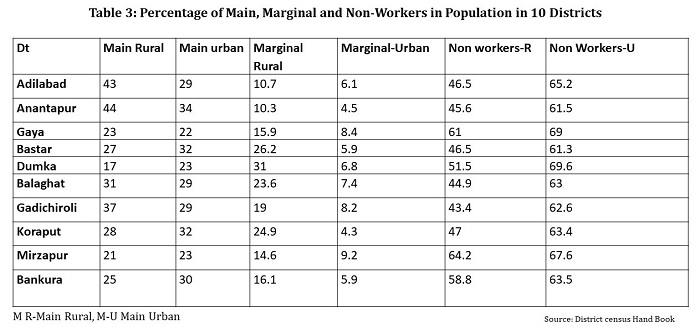
It would be observed that most districts have a very low percentage of main (workers who have work for six months and more in a year) and marginal workers(workers who have work for less than six months in a year) and a high percentage of non workers(persons who are not in the workforce). This also implies that the dependency burden of households in these districts is very high. Primarily lack of adequate employment opportunities have resulted in such a dire state of affairs.
We next take a look at the occupational pattern in these districts. The table below gives the percentage of workers who are cultivators, agricultural labourers, engaged in household industries and in other occupations.
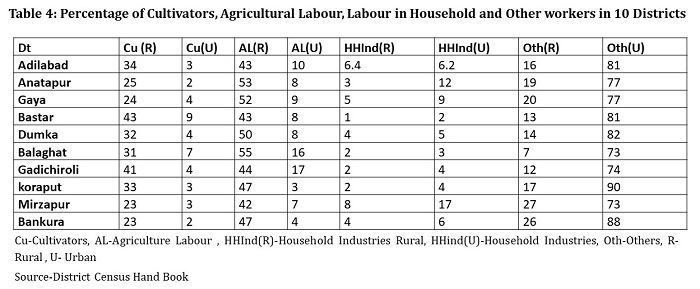
It would be observed that the percentage of agricultural labour far exceeds cultivators in most districts, which only shows that landlessness is a major problem in these districts forcing people to either work as unskilled labour or migrate to other districts or states. The percentage of workers engaged in household industries is also insignificant in most districts except for Adilabad and Mirzapur. The two districts have local village industries in the household sector.
We next examine the social demography of these districts in terms of the proportion of SC/ST population. The Table Below gives the percentage of SC/ST population in the rural and urban areas along with the state percentage for this population.
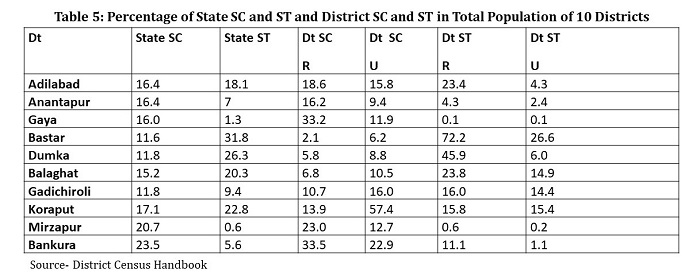
It would be observed from the above table that most districts have a large proportion of the tribal population in the rural areas which is higher than the state percentage. Most of the tribal population in these districts lives in the rural areas. Much of the tribal population is most vulnerable to social and economic deprivation and is often left out of the main stream development process.
We would next see the land-use pattern in the districts to get an idea about the state of agriculture which is the main stay of these districts.

It would be observed that in most districts the percentage area under cultivation and irrigation is low and therefore agriculture has not been able to develop in these districts. As a result the number the job opportunities generated in this sector are also low as the data given in table three on main and marginal workers shows the low percentage of these workers .
We would in the next section discuss what could be done to improve skills and employment in the districts given their difficulties which we have discussed so far.
Section Three: Developing skill and employment strategy
The issue of skills and employment needs to be seen in a two-fold perspective, viz, wage employment and self – employment and in the context of sectors which are local resource based and those which are foot-loose. To understand the local resource base, we would see the important items that are available or that are produced locally in these districts.

It would be seen from the above table that the districts have a potential to produce goods based on natural resources and traditional skills that are locally available. Many of them are inhabited by tribal communities who have over the generations inherited skills that are conducive for the growth of cottage and village industries based on the artisanal skills. The local industries that have a potential to develop are based on wood, bamboo, cotton, silk, leather, metal, pottery, minor forest produce, agro-based edible oil, cement and cement products.
The National Skill development Corporation (NSDC) has carried skill-gap studies for districts all over the country including some considered for our study and made recommendations for skill development and employment either locally or outside the district. We shall now take a look at these.
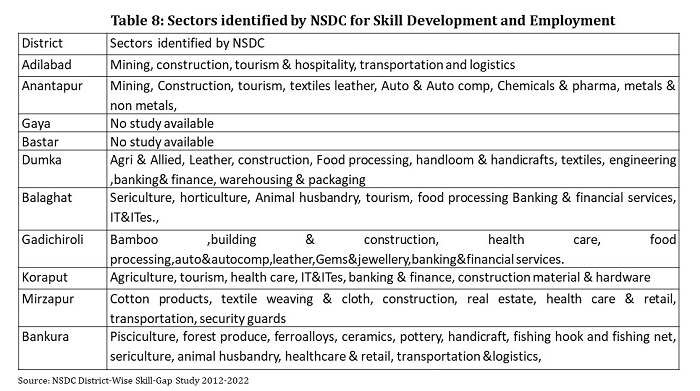
It would be seen from the above table that certain sectors specific to the district and some other sectors foot–loose in nature have been identified keeping the resource endowment of these districts wherever NSDC has carried out the skill-gap studies. It is however noticeable that certain sectors find a mention for many districts. These sectors are construction and tourism. In recent years, construction has been a major employment provider after agriculture. What however needs to be done in the construction sector is to create skilled manpower and for which the training facilities in these districts needs to be improved. Many of these districts have places of historical importance and are also endowed with bountiful flora and fauna. The area needs to be opened up for tourism for which the local youth needs to be given encouragement to become tourist guides and tour operators. This approach would also remove the isolation which many of these districts face and would, therefore, bring them into the main stream of development activities.
In table Seven above we have listed out the important items that are available or could be produced in these districts. While units could be setup to produce them or value-add wherever it is possible to do so through proper training, marketing and financial support, focus needs to be given towards organizational issues so that the local youth could be given an important stake in these organisations. Such importance is very often absent and results in their demotivation. For instance there is a need to organise producers’ cooperatives around important products or the local artisanal skills that are available in the districts. The state authorities would not only have to organize skill development training programmes but nurture formation of producer cooperatives and provide them with the knowledge to begin their business by organising handholding camps to make the local youth confident of managing the cooperatives.
The industry associations, chambers of commerce and local industries both in the private and the public would need to work with the district authorities to identify the skills that could be imparted to the local youth to meet the industry’s requirement and accordingly organize training activities. The local ITIs and polytechnics would also need to be integrated with these activities so that a well planned wage–employment plan which results in the placement of the local youth emerges. The youth would have the option to either get absorbed by the local industries or migrate with adequate skills to other districts for employment.
The various skill development programmes run by the central and state governments need to be converged and integrated with the wage employment plan for the district. A similar approach needs to be taken for formulation of a self-employment plan which culminates in the formation of producers’ cooperatives. All the central and state government programmes would need to converge and integrate with the self-employment plan for the district with the tangible target of forming producers’ cooperative and if these cooperatives are already there, formulate a rejuvenation plan for them.
There is also a need to address the inadequacies in the education and health sectors. We have seen that many of the districts lack adequate facilities for education and health. These sectors form the backbone of any skill development and employability plan of a region for a healthy and educated workforce is the basic requirement for the development of the region. lack of proper education and health facilities would imply that a workforce will not be able to meet the cognitive and physical challenges of a work schedule that involves both physical labour and learning skills to improve overall efficiency and domain knowledge.
Each district would need to do a careful manpower planning which begins with an assessment of the number of entrants in schools and the number of pass outs at the primary, upper primary, secondary and higher secondary levels and those that enter college both for general and technical streams. Simultaneously, the industry associations along with the local industries would need to estimate the demand and the skills sets that would be required by the industry. Such a careful and stage-wise analysis of entrants would give an idea of the actual number of dropouts at every stage so that career planning of children dropping out is carefully done for enhancing their employability and placement through vocational training opportunities at every stage for all children including the drop outs. Such career planning of all children would also make the vocationalisation of school education successful and employability of students easier for it would be in keeping with the actual demand–supply position of jobs for the district. Children unable to get absorbed by the local industry could be prepared for self-employment through skill development courses and thereafter taught how to start an enterprise or form producers’ cooperatives since it may be difficult for all of them to start individual enterprises. The entire education infrastructure of the district including ITIs, polytechnics and degree colleges would need to be involved in the manpower planning exercise along with the industry associations, local industries, training providers and PRIs.
An important source of funding district local plans is The Pradhan Mantri Khanij Kshetra Kalyan Yojana (PMKKKY) which has been launched by The Ministry of Mines. At least 60% of PMKKKY funds will be utilized for high priority areas like: (i) drinking water supply; (ii) environment preservation and pollution control measures; (iii) health care; (iv)education; (v) welfare of women and children; (vi) welfare of aged and disabled people; (vii) skill development; and, (viii) sanitation. The rest of the funds will be utilized undertaking works like for: (i) physical infrastructure; (ii) irrigation; (iii) energy and watershed development; and, (iv) any other measures for enhancing environmental quality in mining district. The scheme could facilitate wholistic development of the mineral rich districts so that the benefits of development reach the local inhabitants.
To conclude, we have raised a few issues that could go towards formulating skills and employment plan for the districts. These are by no means exhaustive. While a lot has been said a lot remains to be done. A systematic and a focused approach with tangible end-results both for wage and self employment is the need taking into consideration the local resources and the infrastructure. More important, the human resource needs of the local inhabitants including their education and health facilities needs to be given due priority if an effective employment plan is to be formulated for the poor districts.
(The author is a former Indian Economic Service Officer in the Government of India, and an expert on matters of Rural Development, Social Justice, Banking, Economic Affairs, Commerce and Industry)
End Notes
1. Singh, Satyajit (2016), Locals in Governance, Oxford University Press, New Delhi.
2. Study on development Interventions in Naxalite Affected Areas in Chattisgarh, (2014), Samarthan Centre for Development Support, Bhopal, www.samarthjan .org.
3. Concept Paper on Appropriate Development Strategies for Effective Implementation of Rural Development Schemes in IAP Districts , Ministry of Rural Development, Government of India, 2011, ruraldiksha.nic.in .
(Views expressed are of the author and do not necessarily reflect the views of the VIF)
Image Source: http://www.buhlergroup.com/global/en/about-buehler/worldwide/buehler-india.htm#.WoZlgufhXIU

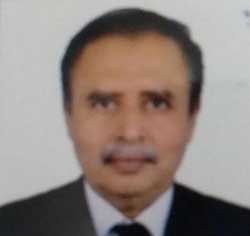








Post new comment